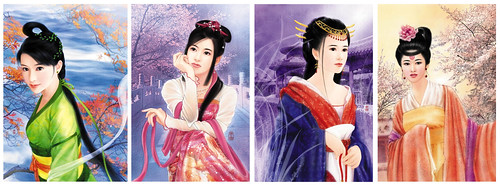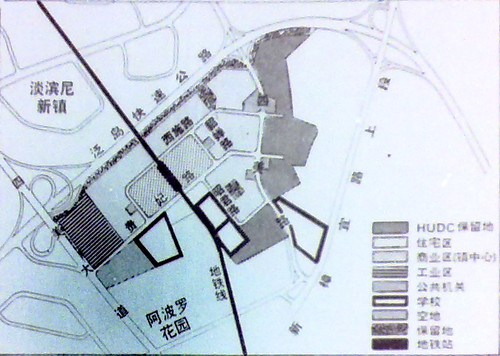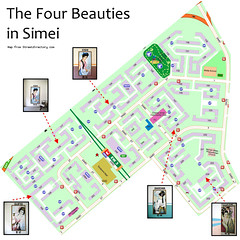Artist's impression of the four classical beauties
After I blogged about the toponymy of Simei here and here, a journalist from U Weekly emailed me about his work on the same topic. It is no coincidence that Jin and I are both males and interested in the four renowned beauties of ancient China who gave the estate its name. His work never came to fruition unfortunately and I lost the chance to read a more professional presentation on the topic. Thankfully Jin shared with me his research and tipped me on two most important piece of information.
The first is graphical evidence that the roads in Simei were indeed named after the four beauties in the beginning. I used to wonder whether this idea, smack of a little Chinese chauvinism, was quashed during the early stage when the estate was first mooted. It seems that the government did go ahead with the naming, with luckless result.
Title reads, "Simei Estate has four beauties; the four mistresses want roads named after them". My translation is crude though the original title is supposed to rhyme a bit. The four beauties are Xishi (西施), Guifei (贵妃), Zhaojun (昭君) and Diaochan (貂蝉).
Edit: I was wrong, the second stanza in the title should read, "4 main roads assume their names". Thanks to Victor who pointed it out. Dead women make no demands. I tripped over the amphiboly in the sentence.
Road named after the four beauties, can you spot them? Only Streets 1 to 4 are visible in the estate. 5 and 6 probably came later. Did they build exactly four roads to fit into the theme as well?
Present day Simei. If the 1986 pictorial strained your eyes, here are the answers to the previous question: St 1 - Xishi; St 2 - Diaochan; St 3 - Guifei; St 4 - Zhaojun. (Image credit: streetdirectory.com)
It is interesting to note how much of the land use today is in the original plan seen in the 1986 pictorial. The healthcare facilities are located on land set aside for industry (工业区). Tropical Spring and upcoming Double Bay Residences (TOP: 2015) lie on school plots. Melville Park and HDB blocks 155 - 165 are on land set aside for HUDC (HUDC 保留地).
The road names explain why the portraits were found in their respective places. The block under which a beauty portrait is found is located along the road originally named after the beauty. We are, however, not privy to why a particular road was named after a beauty. The longest road and the only one to connect Simei Ave. and Simei Road was "Guifei Road" (or just Guifei?). Imperial concubine Yang Yuhuan might be his favourite; Xishi, the epitome of Chinese beauty, a close second. The last has to be Diaochan who claimed the shortest road. In the Chinese classic "Romance of the Three Kingdoms", she was a seductress toy who caused the downfall of ministers and generals.
My pictorial guide on finding the four beauties in Simei. Not sure if the Town Council shifts the portraits around for good feng shui. Blogger Cindy Chua left a comment about yet another portrait, either Zhaojun or Guifei, at block 101. From the road heritage, she probably saw Guifei. Zhaojun's "turf" was at Street 4.
The scholar and/or his boss who approved the naming must be fluent speakers of mandarin. Unfortunately they did not represent the demographics of Simei residents. Perhaps they did but a sizeable minority had voiced their displeasure. Jin shared with me the 27 June 1987 article in The Straits Times:
Can you twist your tongue round these names without a slip? Xishi, Diaochan, Guifei and Zhaojun. Residents in Simei Estate have tripped so often over these road names, which are of four Chinese legendary beauties, that the Housing Board have renamed them.Maybe one English-speaking minister twisted and tripped when he took a taxi to Simei, hah.
The problem is one of pronouncing Chinese pinyinised names. The beauties are not known by dialect names which most of our Chinese road names are based on but I'm sure a hokkien or cantonese reading of their names exist. Since the affair smacks of chauvinism and the girls are not part of our heritage (Peck San to Bishan comes to mind), they have to go. From the same Straits Times article:
The roads in this estate near Tampines new town are now simply known as Simei Streets 1, 2, 3 and 4, respectively. The change was made because people have difficulty in pronouncing the pinyinised names, said an official of the Housing Board. For the same reason, another road, Zhenghua Ring Road in Bukit Panjang Estate, is now called Bukit Panjang Ring Road.The portraits are now heritage markers of Simei. Hung forlornly at void decks, they gaze at residents of all races, young and old alike, who are probably unaware that the street outside was once named after the lady in the portrait. If any of you have in your possession photos with the Simei road signs showing the old pinyinised name, do drop me a note!
One last thing. Jin drew my attention to a point highlighted in the 1 Feb 1986 article that Simei flats cannot exceed 11 floors due to its proximity to the airport. I checked with Google street view, indeed the flats are no higher than that. Even the condominiums seem to obey this rule. However the DBSS Parc Lumiere (TOP: 2011) are eight 12-storey blocks. Later I found out the first residential unit actually starts from 3rd storey, a great workaround.





Pretty sure most if not all the artworks are by this Taiwanese artist Wendy here and here.
ReplyDeleteI may be wrong but I thought 四主要道路取其名 means "4 important roads assume their names" rather than "the four mistresses want roads named after them"? After all, I assume that dead women could make no demands.
ReplyDeleteI don't agree that the names are hard to pronounce. It could be that the authorities did not want the place to sound like a Chinese town, so they renamed the roads.
ReplyDeleteAnother thing, the 4 beauties have little relevance in our society. I believe Singaporeans who like the names are mostly those who are knowledgeable about or interested in Chinese culture and history.
Victor, you are right. I misread it, haha.
ReplyDeleteEr... not so right after all. 主要 should mean "main" not "important" which is 重要. So the sentence should be translated as "4 main roads assume their names".
ReplyDeleteDone. I think the title is a bit misleading, because those were the only 4 roads (I think), if we exclude Simei Ave and Simei Road.
ReplyDeleteI mean if Streets 5 and 6 are pioneer roads as well, what were they called in the beginning? They did not change name, according to the news article.
Hey Icemoon, thanks for sharing the info out to your readers. The article *might* come to fruition as a small blurb together with other interesting mature estates in future, cannot reveal too much details as yet.
ReplyDeleteI remember reading an errata or clarification a few days after the 27/6/87 article was published that Bt Panjang wasn't renamed for the same reason, worth checking out.
And actually, you have answered your own question through an earlier post.
ReplyDeleteNotice that in the 15th edition (1988) (post-renaming) map posted right at the end, Simei MRT was not surrounded by any road. :)
I agree with Frannxis' reasoning on why the names were not adopted. There are many roads in Spore where the names are far more difficult to pronounce. I am sure you can think of some examples.
ReplyDeleteAnyway, I dislike names like St 1, Drive 2 etc. The say nothing. I prefer street names that carry some meaning. For example those in Changi were named after air bases in England. The other day, I blogged about streets in Sembawang named after small Commonwealth countries like Cyprus, Malta, etc. In my estate, the streets all bear the names of plants beginning with the letter L, e.g Lily, Lotus, Lantana etc. Nearby in Eden Park, the roads bear the names of deciduos (hope that's the correct term) trees like Fir, Maple, Redwood etc.
Hello I'm back again. =)
ReplyDeleteI'm here to confirm that block 101 is Guifei and there's another Diaochan at block 141! ^^
I guess that there are duplicates for the four beauties. And you can always spot their portraits when you're on the streets. Except for Zhaojun hiding behind the wall. Think they want people to know that they exists.
I have confirmed that there are indeed duplicates for each of the Four Beauties of Simei. Their locations are as follows:
ReplyDeleteXishi (Simei St 1) - Blocks 116 and 123
Diaochan (Simei St 2) - Blocks 141 and 146
Guifei (Simei St 3) - Blocks 101 and 107
Zhaojun (Simei St 4) - Blocks 226 and 229
It's worth noting that the positioning of the same Beauties' portraits actually exhibits some symmetry. It seems that the blocks' layout, in the areas where the portraits are, were constructed with a mirror symmetry in mind. The positions of the portrait pairs actually reflect (pardon the pun) this inherent symmetry.
Nice to know that the engineers who laid out the plans for Simei appreciate the beauty in symmetry.
Wow, that's a revelation from Anon! I only managed to find a duplicate Xishi during my visit. So embarrassing to have claimed to comb the entire estate, yet missed three of them.
ReplyDeleteI will add the information to this post. Once again, thanks!
Thks Icemoon and all for sharing the info. I found yr blog by luck, shame on me who stayed in Simei for almost 18 years only start to look out for the portraits of the 4 beauties recently.Will be walking around to take pictures of them.
ReplyDeleteHello Baby Ele, thanks. Hopefully you Simeites can update us on the status of the portraits.
ReplyDeletehi, i would like to aks if you have asoft copy of the straits times 1987 article on this simei district? i would like to use it for my assignment.
ReplyDelete